Communication Skills: Barriers, Skills, and Solutions Report
VerifiedAdded on 2023/01/18
|6
|1428
|92
Report
AI Summary
This report delves into the crucial aspects of communication skills, focusing on the barriers encountered during interactions, particularly with children. It begins with an introduction to communication, emphasizing its two-way nature and importance in building relationships. A case study involving interactions with children highlights real-world communication challenges, such as lack of time, poor perception, emotional factors, distractions, technology, and limited expression capabilities. The report then identifies communication barriers and proposes effective communication skills to overcome them. These include active listening, avoiding distractions, spending quality time, communicating clearly and slowly, and making direct eye contact. The report concludes by reiterating the significance of effective communication and offering strategies to improve communication skills.
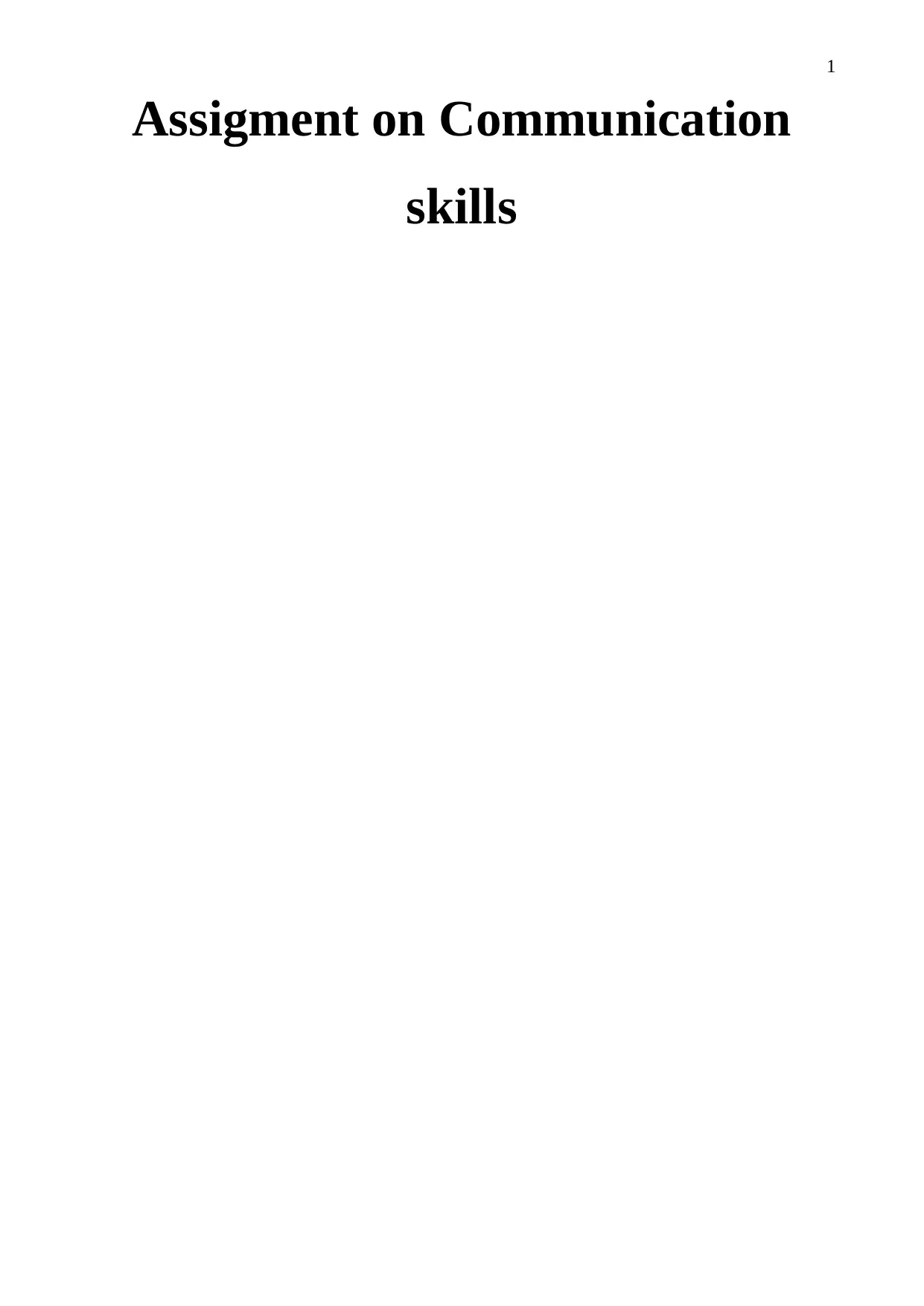
1
Assigment on Communication
skills
Assigment on Communication
skills
Paraphrase This Document
Need a fresh take? Get an instant paraphrase of this document with our AI Paraphraser
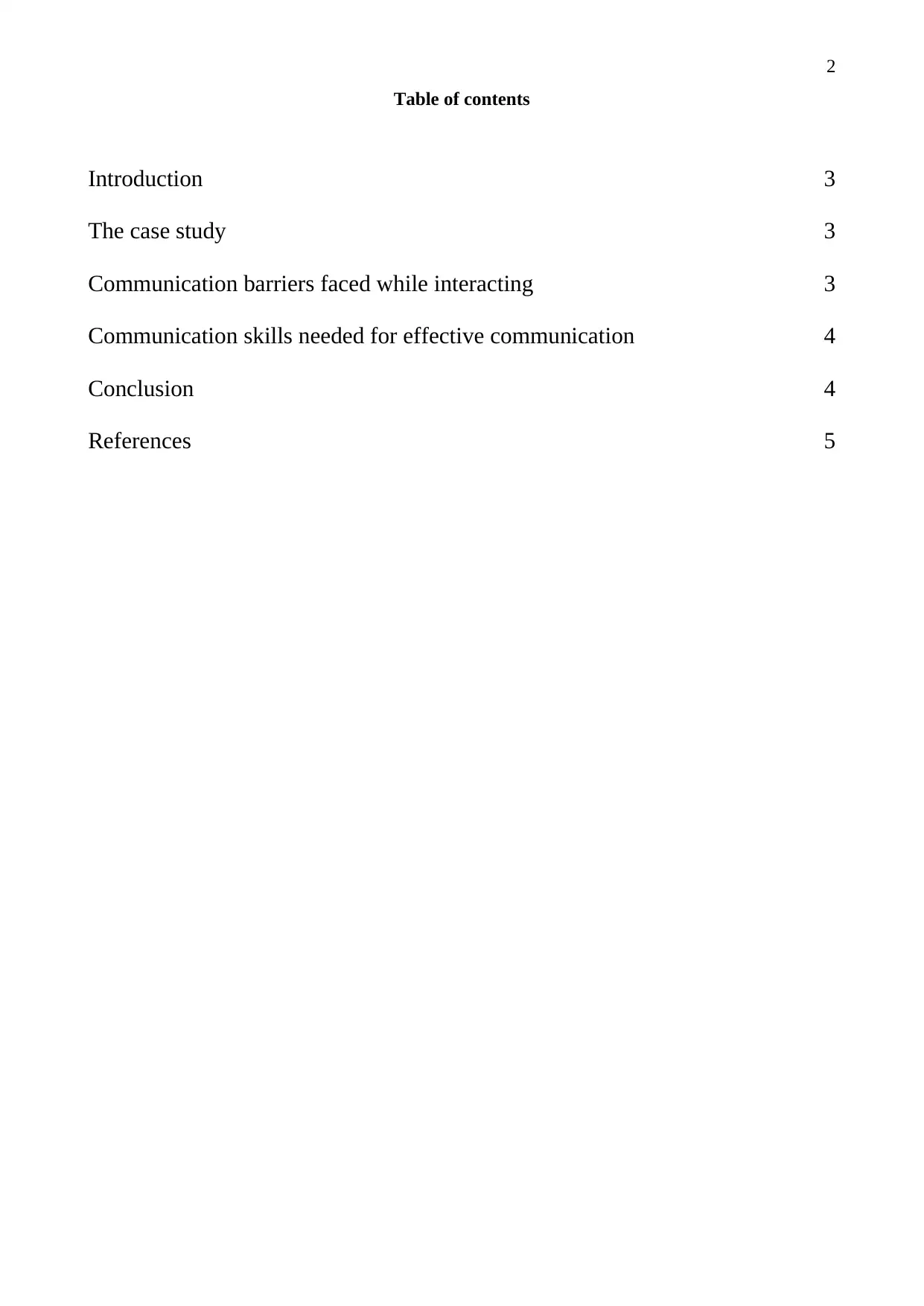
2
Table of contents
Introduction 3
The case study 3
Communication barriers faced while interacting 3
Communication skills needed for effective communication 4
Conclusion 4
References 5
Table of contents
Introduction 3
The case study 3
Communication barriers faced while interacting 3
Communication skills needed for effective communication 4
Conclusion 4
References 5
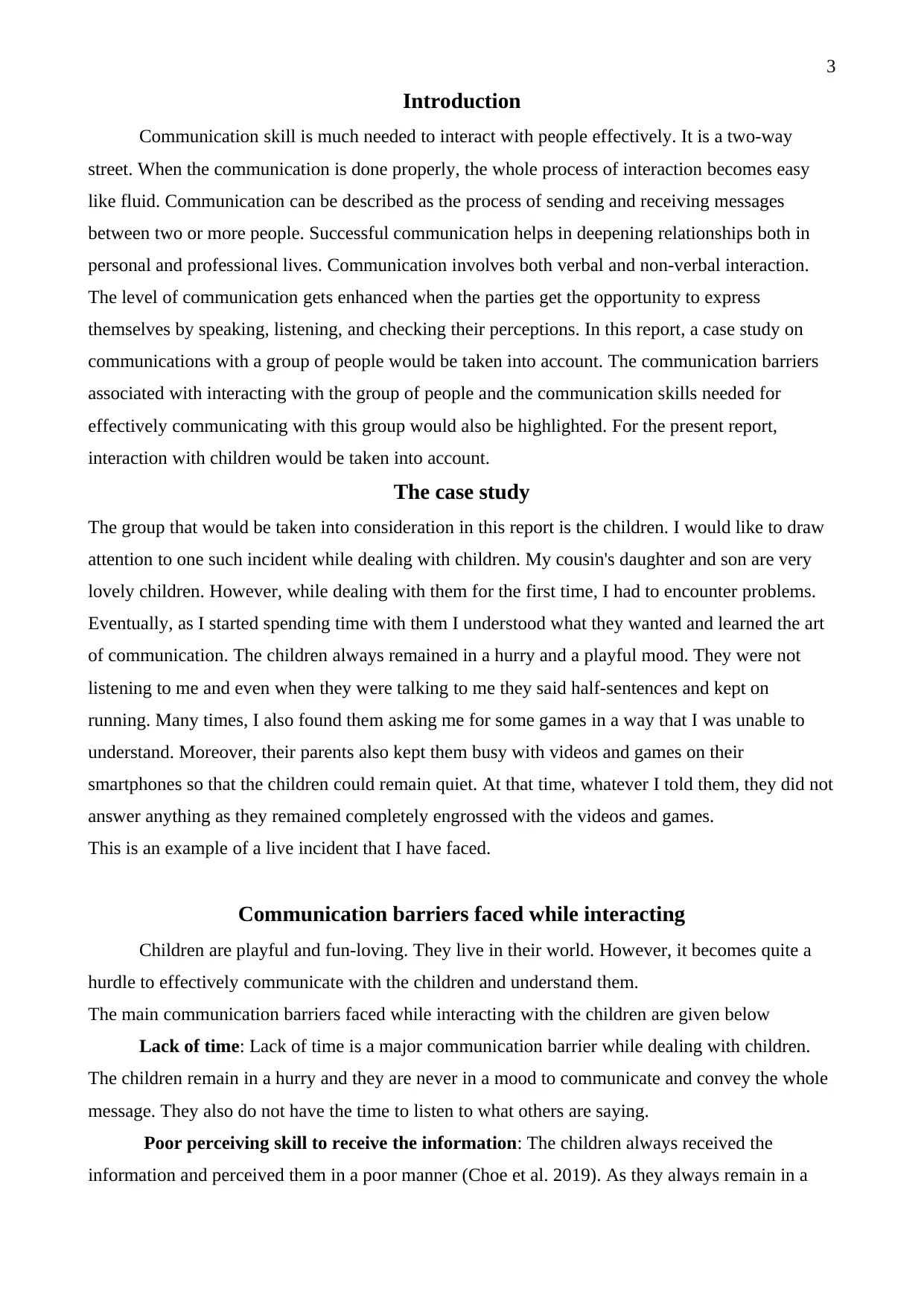
3
Introduction
Communication skill is much needed to interact with people effectively. It is a two-way
street. When the communication is done properly, the whole process of interaction becomes easy
like fluid. Communication can be described as the process of sending and receiving messages
between two or more people. Successful communication helps in deepening relationships both in
personal and professional lives. Communication involves both verbal and non-verbal interaction.
The level of communication gets enhanced when the parties get the opportunity to express
themselves by speaking, listening, and checking their perceptions. In this report, a case study on
communications with a group of people would be taken into account. The communication barriers
associated with interacting with the group of people and the communication skills needed for
effectively communicating with this group would also be highlighted. For the present report,
interaction with children would be taken into account.
The case study
The group that would be taken into consideration in this report is the children. I would like to draw
attention to one such incident while dealing with children. My cousin's daughter and son are very
lovely children. However, while dealing with them for the first time, I had to encounter problems.
Eventually, as I started spending time with them I understood what they wanted and learned the art
of communication. The children always remained in a hurry and a playful mood. They were not
listening to me and even when they were talking to me they said half-sentences and kept on
running. Many times, I also found them asking me for some games in a way that I was unable to
understand. Moreover, their parents also kept them busy with videos and games on their
smartphones so that the children could remain quiet. At that time, whatever I told them, they did not
answer anything as they remained completely engrossed with the videos and games.
This is an example of a live incident that I have faced.
Communication barriers faced while interacting
Children are playful and fun-loving. They live in their world. However, it becomes quite a
hurdle to effectively communicate with the children and understand them.
The main communication barriers faced while interacting with the children are given below
Lack of time: Lack of time is a major communication barrier while dealing with children.
The children remain in a hurry and they are never in a mood to communicate and convey the whole
message. They also do not have the time to listen to what others are saying.
Poor perceiving skill to receive the information: The children always received the
information and perceived them in a poor manner (Choe et al. 2019). As they always remain in a
Introduction
Communication skill is much needed to interact with people effectively. It is a two-way
street. When the communication is done properly, the whole process of interaction becomes easy
like fluid. Communication can be described as the process of sending and receiving messages
between two or more people. Successful communication helps in deepening relationships both in
personal and professional lives. Communication involves both verbal and non-verbal interaction.
The level of communication gets enhanced when the parties get the opportunity to express
themselves by speaking, listening, and checking their perceptions. In this report, a case study on
communications with a group of people would be taken into account. The communication barriers
associated with interacting with the group of people and the communication skills needed for
effectively communicating with this group would also be highlighted. For the present report,
interaction with children would be taken into account.
The case study
The group that would be taken into consideration in this report is the children. I would like to draw
attention to one such incident while dealing with children. My cousin's daughter and son are very
lovely children. However, while dealing with them for the first time, I had to encounter problems.
Eventually, as I started spending time with them I understood what they wanted and learned the art
of communication. The children always remained in a hurry and a playful mood. They were not
listening to me and even when they were talking to me they said half-sentences and kept on
running. Many times, I also found them asking me for some games in a way that I was unable to
understand. Moreover, their parents also kept them busy with videos and games on their
smartphones so that the children could remain quiet. At that time, whatever I told them, they did not
answer anything as they remained completely engrossed with the videos and games.
This is an example of a live incident that I have faced.
Communication barriers faced while interacting
Children are playful and fun-loving. They live in their world. However, it becomes quite a
hurdle to effectively communicate with the children and understand them.
The main communication barriers faced while interacting with the children are given below
Lack of time: Lack of time is a major communication barrier while dealing with children.
The children remain in a hurry and they are never in a mood to communicate and convey the whole
message. They also do not have the time to listen to what others are saying.
Poor perceiving skill to receive the information: The children always received the
information and perceived them in a poor manner (Choe et al. 2019). As they always remain in a
⊘ This is a preview!⊘
Do you want full access?
Subscribe today to unlock all pages.

Trusted by 1+ million students worldwide
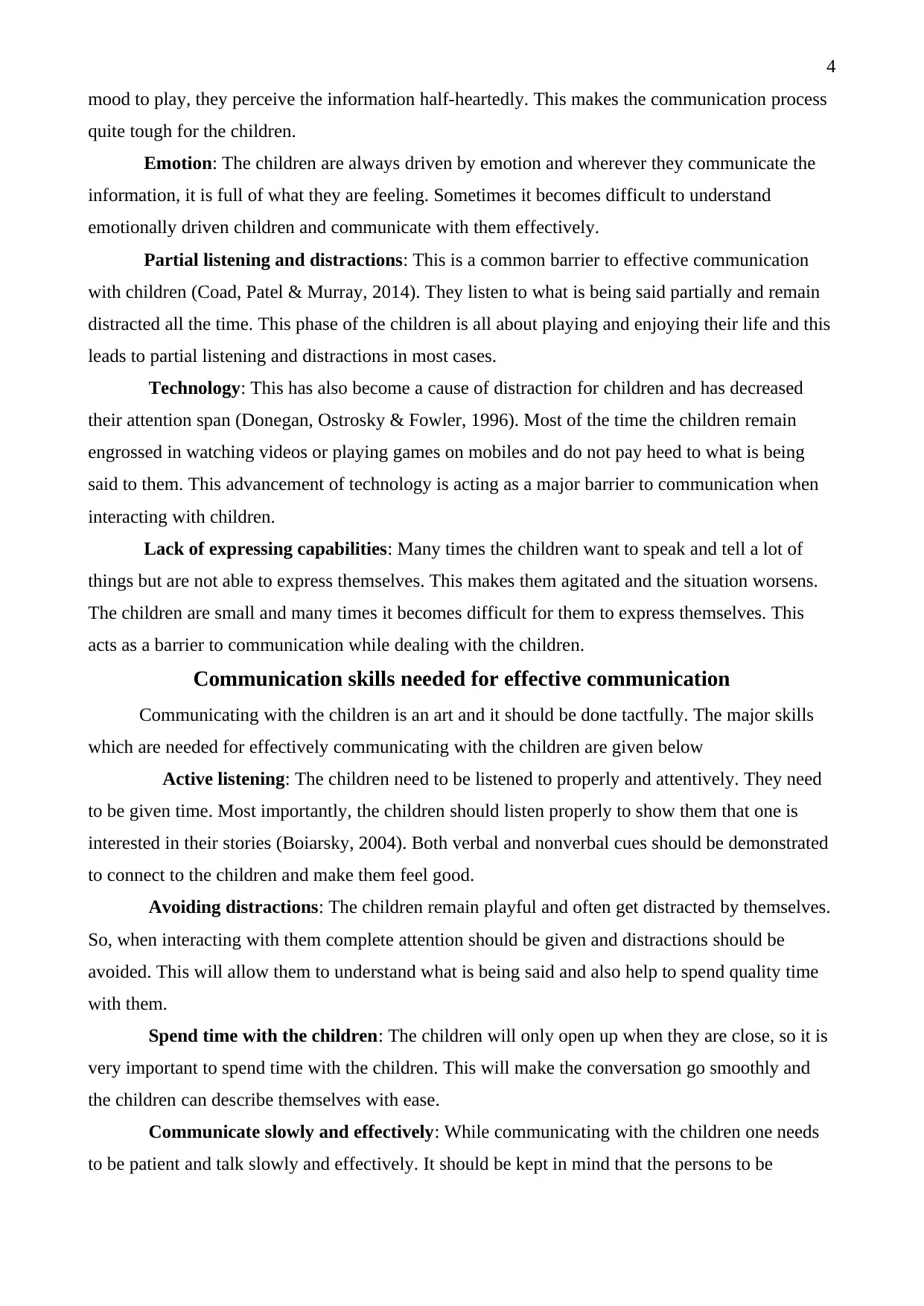
4
mood to play, they perceive the information half-heartedly. This makes the communication process
quite tough for the children.
Emotion: The children are always driven by emotion and wherever they communicate the
information, it is full of what they are feeling. Sometimes it becomes difficult to understand
emotionally driven children and communicate with them effectively.
Partial listening and distractions: This is a common barrier to effective communication
with children (Coad, Patel & Murray, 2014). They listen to what is being said partially and remain
distracted all the time. This phase of the children is all about playing and enjoying their life and this
leads to partial listening and distractions in most cases.
Technology: This has also become a cause of distraction for children and has decreased
their attention span (Donegan, Ostrosky & Fowler, 1996). Most of the time the children remain
engrossed in watching videos or playing games on mobiles and do not pay heed to what is being
said to them. This advancement of technology is acting as a major barrier to communication when
interacting with children.
Lack of expressing capabilities: Many times the children want to speak and tell a lot of
things but are not able to express themselves. This makes them agitated and the situation worsens.
The children are small and many times it becomes difficult for them to express themselves. This
acts as a barrier to communication while dealing with the children.
Communication skills needed for effective communication
Communicating with the children is an art and it should be done tactfully. The major skills
which are needed for effectively communicating with the children are given below
Active listening: The children need to be listened to properly and attentively. They need
to be given time. Most importantly, the children should listen properly to show them that one is
interested in their stories (Boiarsky, 2004). Both verbal and nonverbal cues should be demonstrated
to connect to the children and make them feel good.
Avoiding distractions: The children remain playful and often get distracted by themselves.
So, when interacting with them complete attention should be given and distractions should be
avoided. This will allow them to understand what is being said and also help to spend quality time
with them.
Spend time with the children: The children will only open up when they are close, so it is
very important to spend time with the children. This will make the conversation go smoothly and
the children can describe themselves with ease.
Communicate slowly and effectively: While communicating with the children one needs
to be patient and talk slowly and effectively. It should be kept in mind that the persons to be
mood to play, they perceive the information half-heartedly. This makes the communication process
quite tough for the children.
Emotion: The children are always driven by emotion and wherever they communicate the
information, it is full of what they are feeling. Sometimes it becomes difficult to understand
emotionally driven children and communicate with them effectively.
Partial listening and distractions: This is a common barrier to effective communication
with children (Coad, Patel & Murray, 2014). They listen to what is being said partially and remain
distracted all the time. This phase of the children is all about playing and enjoying their life and this
leads to partial listening and distractions in most cases.
Technology: This has also become a cause of distraction for children and has decreased
their attention span (Donegan, Ostrosky & Fowler, 1996). Most of the time the children remain
engrossed in watching videos or playing games on mobiles and do not pay heed to what is being
said to them. This advancement of technology is acting as a major barrier to communication when
interacting with children.
Lack of expressing capabilities: Many times the children want to speak and tell a lot of
things but are not able to express themselves. This makes them agitated and the situation worsens.
The children are small and many times it becomes difficult for them to express themselves. This
acts as a barrier to communication while dealing with the children.
Communication skills needed for effective communication
Communicating with the children is an art and it should be done tactfully. The major skills
which are needed for effectively communicating with the children are given below
Active listening: The children need to be listened to properly and attentively. They need
to be given time. Most importantly, the children should listen properly to show them that one is
interested in their stories (Boiarsky, 2004). Both verbal and nonverbal cues should be demonstrated
to connect to the children and make them feel good.
Avoiding distractions: The children remain playful and often get distracted by themselves.
So, when interacting with them complete attention should be given and distractions should be
avoided. This will allow them to understand what is being said and also help to spend quality time
with them.
Spend time with the children: The children will only open up when they are close, so it is
very important to spend time with the children. This will make the conversation go smoothly and
the children can describe themselves with ease.
Communicate slowly and effectively: While communicating with the children one needs
to be patient and talk slowly and effectively. It should be kept in mind that the persons to be
Paraphrase This Document
Need a fresh take? Get an instant paraphrase of this document with our AI Paraphraser
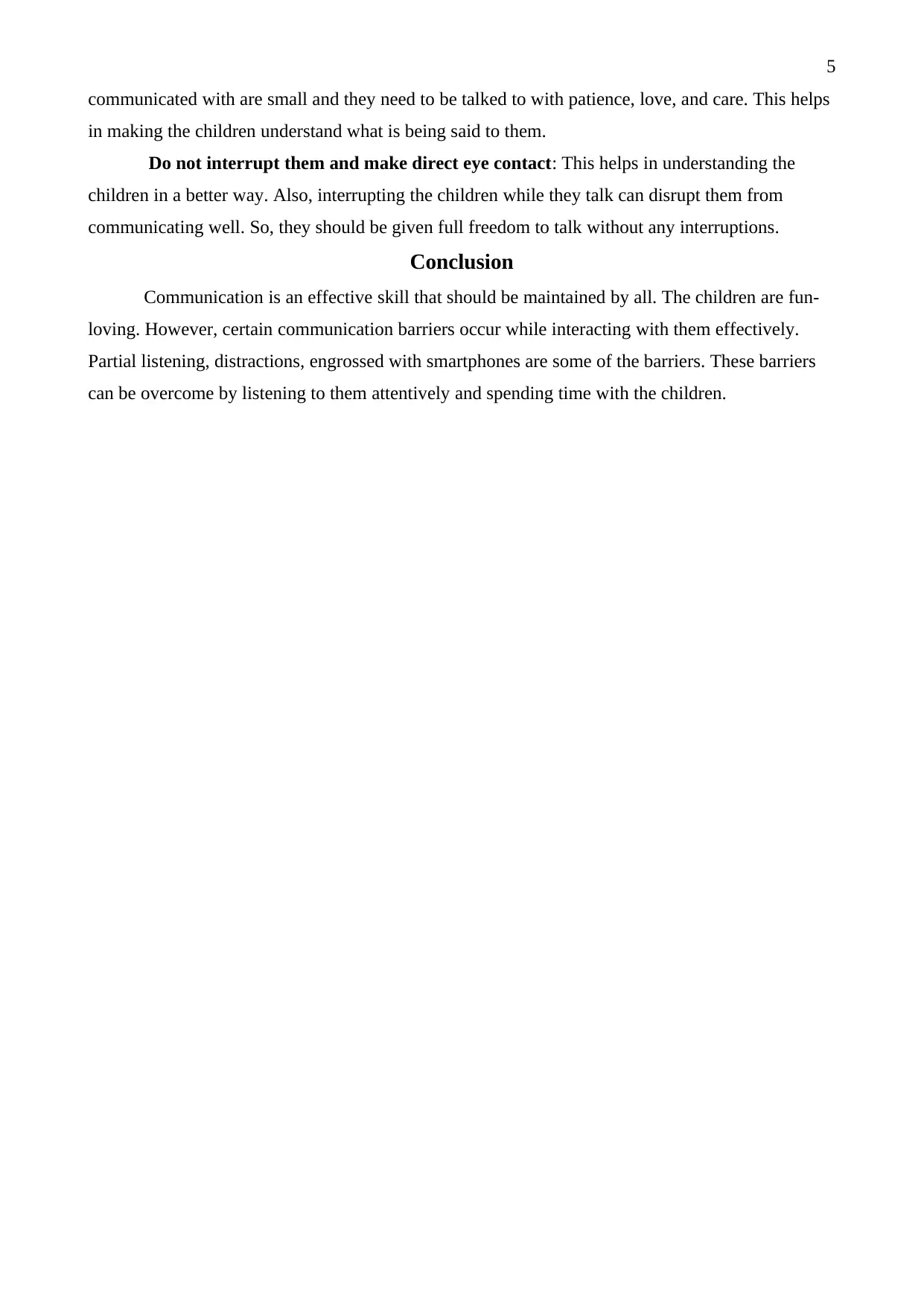
5
communicated with are small and they need to be talked to with patience, love, and care. This helps
in making the children understand what is being said to them.
Do not interrupt them and make direct eye contact: This helps in understanding the
children in a better way. Also, interrupting the children while they talk can disrupt them from
communicating well. So, they should be given full freedom to talk without any interruptions.
Conclusion
Communication is an effective skill that should be maintained by all. The children are fun-
loving. However, certain communication barriers occur while interacting with them effectively.
Partial listening, distractions, engrossed with smartphones are some of the barriers. These barriers
can be overcome by listening to them attentively and spending time with the children.
communicated with are small and they need to be talked to with patience, love, and care. This helps
in making the children understand what is being said to them.
Do not interrupt them and make direct eye contact: This helps in understanding the
children in a better way. Also, interrupting the children while they talk can disrupt them from
communicating well. So, they should be given full freedom to talk without any interruptions.
Conclusion
Communication is an effective skill that should be maintained by all. The children are fun-
loving. However, certain communication barriers occur while interacting with them effectively.
Partial listening, distractions, engrossed with smartphones are some of the barriers. These barriers
can be overcome by listening to them attentively and spending time with the children.
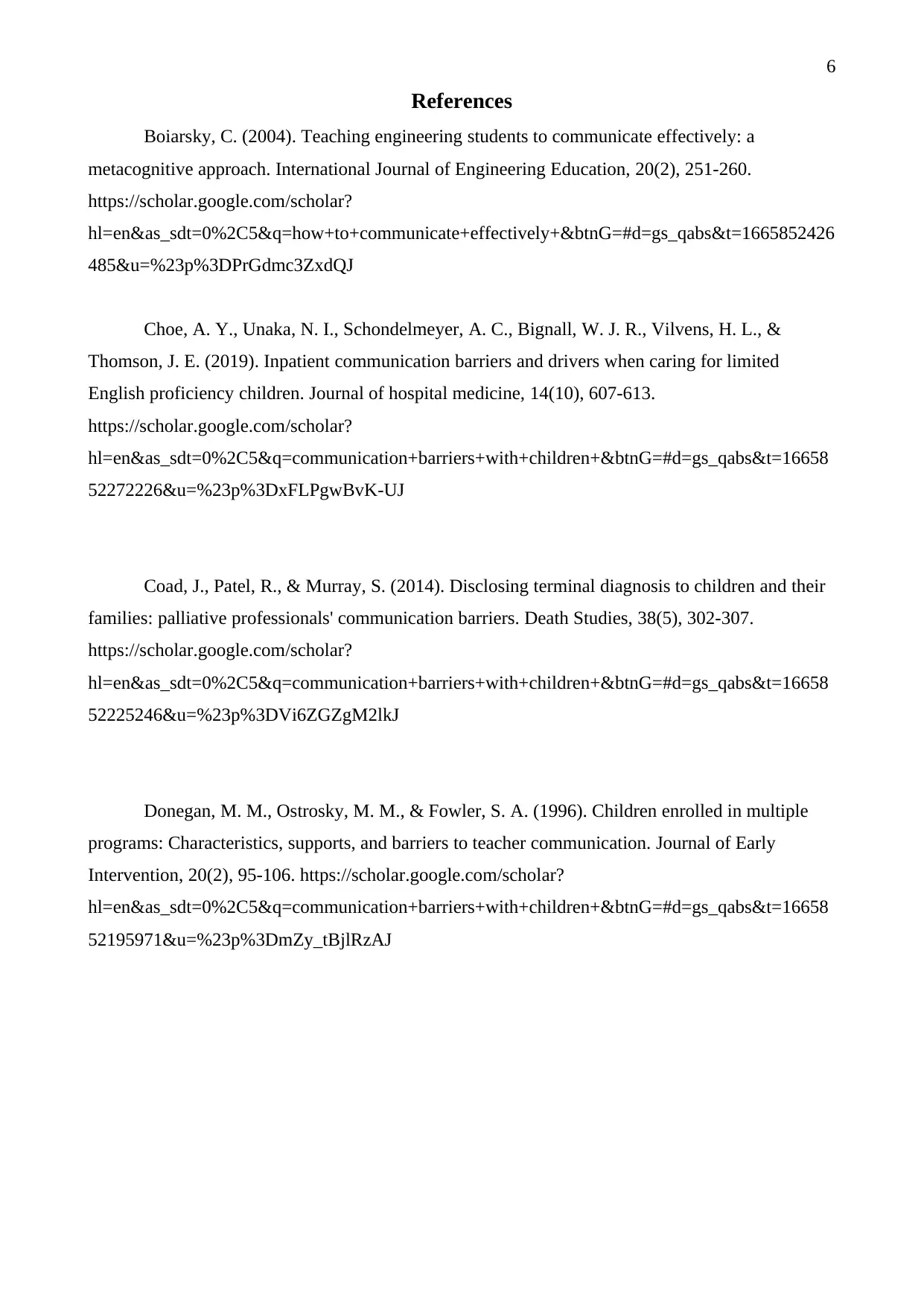
6
References
Boiarsky, C. (2004). Teaching engineering students to communicate effectively: a
metacognitive approach. International Journal of Engineering Education, 20(2), 251-260.
https://scholar.google.com/scholar?
hl=en&as_sdt=0%2C5&q=how+to+communicate+effectively+&btnG=#d=gs_qabs&t=1665852426
485&u=%23p%3DPrGdmc3ZxdQJ
Choe, A. Y., Unaka, N. I., Schondelmeyer, A. C., Bignall, W. J. R., Vilvens, H. L., &
Thomson, J. E. (2019). Inpatient communication barriers and drivers when caring for limited
English proficiency children. Journal of hospital medicine, 14(10), 607-613.
https://scholar.google.com/scholar?
hl=en&as_sdt=0%2C5&q=communication+barriers+with+children+&btnG=#d=gs_qabs&t=16658
52272226&u=%23p%3DxFLPgwBvK-UJ
Coad, J., Patel, R., & Murray, S. (2014). Disclosing terminal diagnosis to children and their
families: palliative professionals' communication barriers. Death Studies, 38(5), 302-307.
https://scholar.google.com/scholar?
hl=en&as_sdt=0%2C5&q=communication+barriers+with+children+&btnG=#d=gs_qabs&t=16658
52225246&u=%23p%3DVi6ZGZgM2lkJ
Donegan, M. M., Ostrosky, M. M., & Fowler, S. A. (1996). Children enrolled in multiple
programs: Characteristics, supports, and barriers to teacher communication. Journal of Early
Intervention, 20(2), 95-106. https://scholar.google.com/scholar?
hl=en&as_sdt=0%2C5&q=communication+barriers+with+children+&btnG=#d=gs_qabs&t=16658
52195971&u=%23p%3DmZy_tBjlRzAJ
References
Boiarsky, C. (2004). Teaching engineering students to communicate effectively: a
metacognitive approach. International Journal of Engineering Education, 20(2), 251-260.
https://scholar.google.com/scholar?
hl=en&as_sdt=0%2C5&q=how+to+communicate+effectively+&btnG=#d=gs_qabs&t=1665852426
485&u=%23p%3DPrGdmc3ZxdQJ
Choe, A. Y., Unaka, N. I., Schondelmeyer, A. C., Bignall, W. J. R., Vilvens, H. L., &
Thomson, J. E. (2019). Inpatient communication barriers and drivers when caring for limited
English proficiency children. Journal of hospital medicine, 14(10), 607-613.
https://scholar.google.com/scholar?
hl=en&as_sdt=0%2C5&q=communication+barriers+with+children+&btnG=#d=gs_qabs&t=16658
52272226&u=%23p%3DxFLPgwBvK-UJ
Coad, J., Patel, R., & Murray, S. (2014). Disclosing terminal diagnosis to children and their
families: palliative professionals' communication barriers. Death Studies, 38(5), 302-307.
https://scholar.google.com/scholar?
hl=en&as_sdt=0%2C5&q=communication+barriers+with+children+&btnG=#d=gs_qabs&t=16658
52225246&u=%23p%3DVi6ZGZgM2lkJ
Donegan, M. M., Ostrosky, M. M., & Fowler, S. A. (1996). Children enrolled in multiple
programs: Characteristics, supports, and barriers to teacher communication. Journal of Early
Intervention, 20(2), 95-106. https://scholar.google.com/scholar?
hl=en&as_sdt=0%2C5&q=communication+barriers+with+children+&btnG=#d=gs_qabs&t=16658
52195971&u=%23p%3DmZy_tBjlRzAJ
⊘ This is a preview!⊘
Do you want full access?
Subscribe today to unlock all pages.

Trusted by 1+ million students worldwide
1 out of 6
Related Documents
Your All-in-One AI-Powered Toolkit for Academic Success.
+13062052269
info@desklib.com
Available 24*7 on WhatsApp / Email
![[object Object]](/_next/static/media/star-bottom.7253800d.svg)
Unlock your academic potential
Copyright © 2020–2025 A2Z Services. All Rights Reserved. Developed and managed by ZUCOL.





